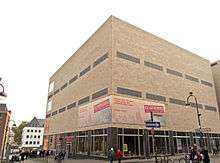Wallraf-Richartz Museum
 Wallraf-Richartz-Museum | |
 Location of Wallraf-Richartz-Museum & Foundation Corboud in Germany | |
| Established | July 1, 1871 |
|---|---|
| Location |
Obenmarspforten 40 Am Kölner Rathaus 50667 Cologne, Germany |
| Coordinates | 50°56′16″N 6°57′33″E / 50.9378848°N 6.9592605°E |
| Collection size |
European Fine art: Gothic, Renaissance, Baroque, Impressionist |
| Director | Dr. Marcus Dekiert |
| Public transit access | 5 16 18 Köln Hbf |
| Website | Official website |
The Wallraf-Richartz-Museum & Fondation Corboud is one of the three major museums in Cologne, Germany. It houses an art gallery with a collection of fine art from the medieval period to the early twentieth century.
History
The museum dates back to the year 1824, when the comprehensive collection of medieval art from Franz Ferdinand Wallraf came to the city of Cologne by inheritance. The first building was donated by Johann Heinrich Richartz, and the museum was opened in 1861.[1]
The collection was regularly expanded by donations, especially the Haubrich collection of contemporary art, in 1946. In 1976, on the occasion of the donation of Mr. and Mrs. Ludwig, the collection was split. The new Museum Ludwig took over the exhibition of the 20th century art.
The current building from 2001, near the Cologne City Hall, was designed by Oswald Mathias Ungers. Also in 2001, Swiss collector Gérard Corboud gave his comprehensive impressionist and postimpressionist collection to the museum as a permanent loan. The museum then added “Fondation Corboud” to its name.
Collections

Gothic collection
The Madonna in the Rose Bower, shown at right, is among the Gothic paintings in the collection of the Wallraf-Richartz Museum. It was created by Stefan Lochner, who lived in Germany between 1410 and 1451, mainly working in Cologne. He is considered a late Gothic painter. His work usually has a clean appearance, combining the Gothic attention to long flowing lines with brilliant colors and a Flemish influence of realism and attention to detail. This painting is considered typical of his style. It was executed about 1450, and shows the Virgin and Child reposing in a blooming rose arbor that is attended by Lochner's characteristic, child angels.
Renaissance collection
The Wallraf-Richartz-Museum houses an altarpiece (1515) from the Great Saint Martin Church in Cologne, one of the few known works by Jacob van Utrecht. Among other early Renaissance works in the collection are the Adoration of the Child by Hieronymous Bosch, and a panel of the Jabach Altarpiece by Albrecht Dürer.
Baroque collection
Among the artists in the collection from the Baroque through Rococo period are works by Rubens (Juno and Argus, 1610); Rembrandt (self-portrait); Jordaens; Frans Snyders; van Dyck; Frans Hals; Gerard van Honthorst; Pieter de Hooch; Gerard de Lairesse; François Boucher; Nicolas de Largillierre; Jean-Honoré Fragonard; Marguerite Gérard, and Giambattista Pittoni.[2]

Impressionist collection
The Wallraf-Richartz collection includes Child among staked roses or "Kind zwischen Stockrosen", which was painted by the Impressionist painter Berthe Morisot, in 1881.
In 1864, paintings by Morisot began to be admitted for exhibition in the highly esteemed Salon de Paris. Sponsored by the government and judged by academicians, the Salon is the annual juried exhibition of the best new paintings and sculptures, the official art exhibition of the Académie des beaux-arts in Paris. Morisot's work continued to be selected for exhibition in the salon for ten years before, in 1874, she joined the "rejected" Impressionists in the first of their own exhibitions. Organized by Cézanne, Degas, Monet, Morisot, Pissarro, Renoir, and Sisley, it was held at the studio of the photographer, Nadar.
Monet forgery discovered
On February 14, 2008, the Wallraf-Richartz Museum announced that On the Banks of the Seine by Port Villez, attributed to Claude Monet, was a forgery. The discovery was made when the painting was examined by restorers prior to an upcoming Impressionism exhibition. X-ray and infrared testing revealed that a "colorless substance" had been applied to the canvas to make it appear older. The picture was acquired by the museum in 1954. The museum, which will keep the forgery, still has five authentic Monet paintings in its collection.[3]
Gallery of art
 Adoration of the Child by Hieronymus Bosch, c.1568 or later
Adoration of the Child by Hieronymus Bosch, c.1568 or later
 Rubens, Holy Family, 1634
Rubens, Holy Family, 1634 Van Gogh, Langlois Bridge at Arles, 1888
Van Gogh, Langlois Bridge at Arles, 1888 Marianne Stokes, Melisande (Stokes), Tempera on canvas, 1895-1898
Marianne Stokes, Melisande (Stokes), Tempera on canvas, 1895-1898 German postage stamp celebrating 150 years of the Wallraf-Richartz-Museum
German postage stamp celebrating 150 years of the Wallraf-Richartz-Museum
References
- ↑ Josine Ianco-Starrels (June 1, 1986), German Exhibition At Santa Barbara Museum Los Angeles Times.
- ↑ Wallraf Museum website.
- ↑ German museum discovers prized Monet is a fake Archived 18 February 2008 at the Wayback Machine.
External links
| Wikimedia Commons has media related to Wallraf-Richartz-Museum. |
Coordinates: 50°56′15″N 6°57′31″E / 50.93750°N 6.95861°E